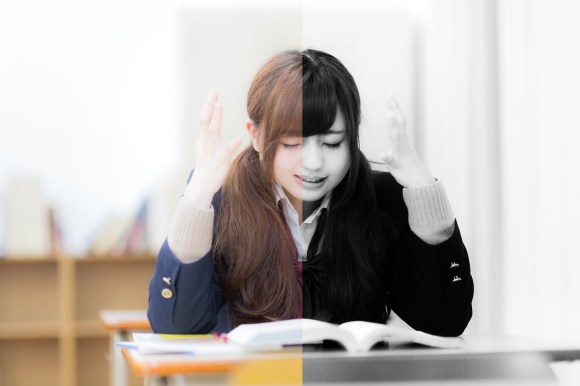
Teachers felt student was disruptive to education with her wild brown hair.
In Osaka District Court, on 27 October, opening arguments were held in the trial of an 18 year-old woman suing Osaka Prefecture for mental anguish over repeated insistence that she dye her naturally brown hair black in order to conform with her school’s dress code.
In junior high, she was forced to continuously dye her hair black and hated every moment of it. So, when it came time to enter high school, the plaintiff’s mother tried to make arrangements with Kaifukan High School in Habikino City in order to not repeat the same awful experience.
● Natural Hair Color Registry
Some high schools in the Osaka area have introduced a Natural Hair Color Registry where students with non-black hair can become identified as such and not face the scorn of their school. At the time of enrolment, students have the color values of their hair measured and put on record so that staff can check if it has been altered.
Some Tokyo schools are said to have a similar system wherein students can get a Natural Hair Color Certificate to confirm that they aren’t dying.
According to the complaint, the plaintiff’s mother asked her high school if they had a Natural Hair Color Registry that she could sign up for, but they said they did not. Nevertheless, she seemed satisfied enough with the overall response from the administration and signed her daughter up.
● Our School has a no-dye policy, so you must dye your hair
However, after classes commenced, the plaintiff began getting occasional warnings from teachers and counsellors every week or two. The staff of the school, feeling duty-bound by the school’s no-dye/no-bleach policy, wanted the plaintiff to dye her hair black in conformity with the majority of the student body.
Lawyers for the defense argued that, “For example, even blonde foreign students are required by the rules to dye their hair black.” It bears repeating; the absurdity that they are required to dye their hair by a rule intended to prohibit dying of hair.
Nevertheless, tensions between staff and the plaintiff escalated and by the second semester of her second year, warnings to dye her hair black had increased to about every four days. Due to the repeated dye jobs the plaintiff’s hair had become brittle and a rash developed on her scalp.
● Blacklisted
During this time, she was also prohibited from taking part in school festivals and field trips because of her hair color.
During one “warning” a teacher asked, “Is it because you have a single mother, that you always change your hair color to brown?” The incident caused the plaintiff to hyperventilate and be rushed to hospital.
Finally, in September of last year, one teacher told the plaintiff, “If you’re not going to dye your hair black then you don’t need to come to school.” So she never went back.
In April of this year, the school removed her name from its list of students and allegedly told other parents and students that she had been expelled.
Having pretty much lost her education due to the color of her hair, the plaintiff is suing the Osaka Prefectural government for 2.2 million yen (US$19,000) in damages from what her lawyers say amounts to systematic and institutionalized “bullying.”
● DNA code
The school and board of education have refused to comment on the case as it is ongoing, but defense lawyers have requested that the case be thrown out of court.
Junior high and high schools in Japan are notorious for the severity of their dress codes, in some cases pushing it to its limits. However, a line certainly needs to be drawn somewhere. In order to balance the desire for “harmony” of the student body and a student’s right to protect their own body, the Natural Hair Color Registry is a popular solution, but is not considered mandatory by boards of education and left up to each school’s discretion.
A principal for one of the schools, which has a Natural Hair Color Registry of only ten students, told Mainichi Shimbun, “We’ll continue this system in order to protect the human rights of our students.”
Source: Asahi Shimbun, Mainichi Shimbun
Images: Pakutaso 1, 2 (Edited by SoraNews24)


 Tokyo public schools will stop forcing students with non-black hair to dye it, official promises
Tokyo public schools will stop forcing students with non-black hair to dye it, official promises “Students are only allowed three sneezes in class” Japanese people share their worst school rules
“Students are only allowed three sneezes in class” Japanese people share their worst school rules Anime magical girl spokesmodel tells Japanese women not to feel bad about dying their hair【Video】
Anime magical girl spokesmodel tells Japanese women not to feel bad about dying their hair【Video】 Japanese junior high school girl removed for class from three days for grooming her eyebrows
Japanese junior high school girl removed for class from three days for grooming her eyebrows ALT in Japan asked to remove earrings by Board of Education
ALT in Japan asked to remove earrings by Board of Education Foreigner’s request for help in Tokyo makes us sad for the state of society
Foreigner’s request for help in Tokyo makes us sad for the state of society Seaside scenery, history, and so many desserts on Yokohama’s Akai Kutsu【Japan Loop Buses】
Seaside scenery, history, and so many desserts on Yokohama’s Akai Kutsu【Japan Loop Buses】 Ghibli Park now selling “Grilled Frogs” from food cart in Valley of Witches
Ghibli Park now selling “Grilled Frogs” from food cart in Valley of Witches Red light district sushi restaurant in Tokyo shows us just how wrong we were about it
Red light district sushi restaurant in Tokyo shows us just how wrong we were about it Japan’s summertime towelket pillowcases are even better with the addition of Ghibli stars【Photos】
Japan’s summertime towelket pillowcases are even better with the addition of Ghibli stars【Photos】 Should you add tartar sauce to Japanese curry rice? CoCo Ichi makes diners an unusual offer
Should you add tartar sauce to Japanese curry rice? CoCo Ichi makes diners an unusual offer Mikado Coffee is a 76-year-old coffee chain with a major celebrity connection
Mikado Coffee is a 76-year-old coffee chain with a major celebrity connection Akihabara pop-up shop sells goods made by Japanese prison inmates
Akihabara pop-up shop sells goods made by Japanese prison inmates Spy on North Korea for Only 32 Cents!
Spy on North Korea for Only 32 Cents! Japanese ramen restaurants under pressure from new yen banknotes
Japanese ramen restaurants under pressure from new yen banknotes McDonald’s new Happy Meals offer up cute and practical Sanrio lifestyle goods
McDonald’s new Happy Meals offer up cute and practical Sanrio lifestyle goods French Fries Bread in Tokyo’s Shibuya becomes a hit on social media
French Fries Bread in Tokyo’s Shibuya becomes a hit on social media New private rooms on Tokaido Shinkansen change the way we travel from Tokyo to Kyoto
New private rooms on Tokaido Shinkansen change the way we travel from Tokyo to Kyoto Tokyo Tsukiji fish market site to be redeveloped with 50,000-seat stadium, hotel, shopping center
Tokyo Tsukiji fish market site to be redeveloped with 50,000-seat stadium, hotel, shopping center Japanese city loses residents’ personal data, which was on paper being transported on a windy day
Japanese city loses residents’ personal data, which was on paper being transported on a windy day Beautiful Ghibli sealing wax kits let you create accessories and elegant letter decorations【Pics】
Beautiful Ghibli sealing wax kits let you create accessories and elegant letter decorations【Pics】 Secret Kitchen bento serves Japanese flowers, birds, wind and moon in a box, but is it worth it?
Secret Kitchen bento serves Japanese flowers, birds, wind and moon in a box, but is it worth it? New definition of “Japanese whiskey” goes into effect to prevent fakes from fooling overseas buyers
New definition of “Japanese whiskey” goes into effect to prevent fakes from fooling overseas buyers Our Japanese reporter visits Costco in the U.S., finds super American and very Japanese things
Our Japanese reporter visits Costco in the U.S., finds super American and very Japanese things Studio Ghibli releases Kiki’s Delivery Service chocolate cake pouches in Japan
Studio Ghibli releases Kiki’s Delivery Service chocolate cake pouches in Japan All-you-can-drink Starbucks and amazing views part of Tokyo’s new 170 meter-high sky lounge
All-you-can-drink Starbucks and amazing views part of Tokyo’s new 170 meter-high sky lounge More foreign tourists than ever before in history visited Japan last month
More foreign tourists than ever before in history visited Japan last month New Pokémon cakes let you eat your way through Pikachu and all the Eevee evolutions
New Pokémon cakes let you eat your way through Pikachu and all the Eevee evolutions Disney princesses get official manga makeovers for Manga Princess Cafe opening in Tokyo
Disney princesses get official manga makeovers for Manga Princess Cafe opening in Tokyo Sales of Japan’s most convenient train ticket/shopping payment cards suspended indefinitely
Sales of Japan’s most convenient train ticket/shopping payment cards suspended indefinitely Sold-out Studio Ghibli desktop humidifiers are back so Totoro can help you through the dry season
Sold-out Studio Ghibli desktop humidifiers are back so Totoro can help you through the dry season Japanese government to make first change to romanization spelling rules since the 1950s
Japanese government to make first change to romanization spelling rules since the 1950s Ghibli founders Toshio Suzuki and Hayao Miyazaki contribute to Japanese whisky Totoro label design
Ghibli founders Toshio Suzuki and Hayao Miyazaki contribute to Japanese whisky Totoro label design Doraemon found buried at sea as scene from 1993 anime becomes real life【Photos】
Doraemon found buried at sea as scene from 1993 anime becomes real life【Photos】 Tokyo’s most famous Starbucks is closed
Tokyo’s most famous Starbucks is closed One Piece characters’ nationalities revealed, but fans have mixed opinions
One Piece characters’ nationalities revealed, but fans have mixed opinions We asked a Uniqlo employee what four things we should buy and their suggestions didn’t disappoint
We asked a Uniqlo employee what four things we should buy and their suggestions didn’t disappoint Japanese high school teachers forcibly cut off hair that was “too long” from 44 students
Japanese high school teachers forcibly cut off hair that was “too long” from 44 students Petition to allow students to choose what they wear to school gathers almost 19,000 signatures
Petition to allow students to choose what they wear to school gathers almost 19,000 signatures High schooler “forced” to quit school sues Kumamoto prefecture for a single yen
High schooler “forced” to quit school sues Kumamoto prefecture for a single yen Public schools in Japan’s Saga Prefecture will no longer regulate/check students’ underwear color
Public schools in Japan’s Saga Prefecture will no longer regulate/check students’ underwear color Line up in the hall, open your shirts, show your bras – Real instructions from one Japanese school
Line up in the hall, open your shirts, show your bras – Real instructions from one Japanese school Japanese high school teacher in hot water after forcibly giving male student a buzz cut
Japanese high school teacher in hot water after forcibly giving male student a buzz cut “Smooth Hair” poster sparks controversy in Japan
“Smooth Hair” poster sparks controversy in Japan Brazilian man acquitted of sexual assault after kissing Japanese woman on Nagoya train
Brazilian man acquitted of sexual assault after kissing Japanese woman on Nagoya train Japanese high school requires teens to kneel and bow for teaches, receives harsh online backlash
Japanese high school requires teens to kneel and bow for teaches, receives harsh online backlash Court verdict reached on Kyoto schoolgirl who sued bullies for causing her mental illness
Court verdict reached on Kyoto schoolgirl who sued bullies for causing her mental illness Japanese teacher beats up student for making fun of his body by calling him anime character name
Japanese teacher beats up student for making fun of his body by calling him anime character name Do Japanese people think all those anime characters REALLY have blue, pink, and green hair?
Do Japanese people think all those anime characters REALLY have blue, pink, and green hair? Japanese school has ridiculous reason for not letting cold schoolgirl wear tights under her skirt
Japanese school has ridiculous reason for not letting cold schoolgirl wear tights under her skirt Former schoolgirl sues Tokyo high school that made her drop out for breaking no-dating rule
Former schoolgirl sues Tokyo high school that made her drop out for breaking no-dating rule Pantene ad asks why people in Japan are forced to look the same when job hunting
Pantene ad asks why people in Japan are forced to look the same when job hunting American English teacher fired from Japanese high school after exposing genitals
American English teacher fired from Japanese high school after exposing genitals
Leave a Reply